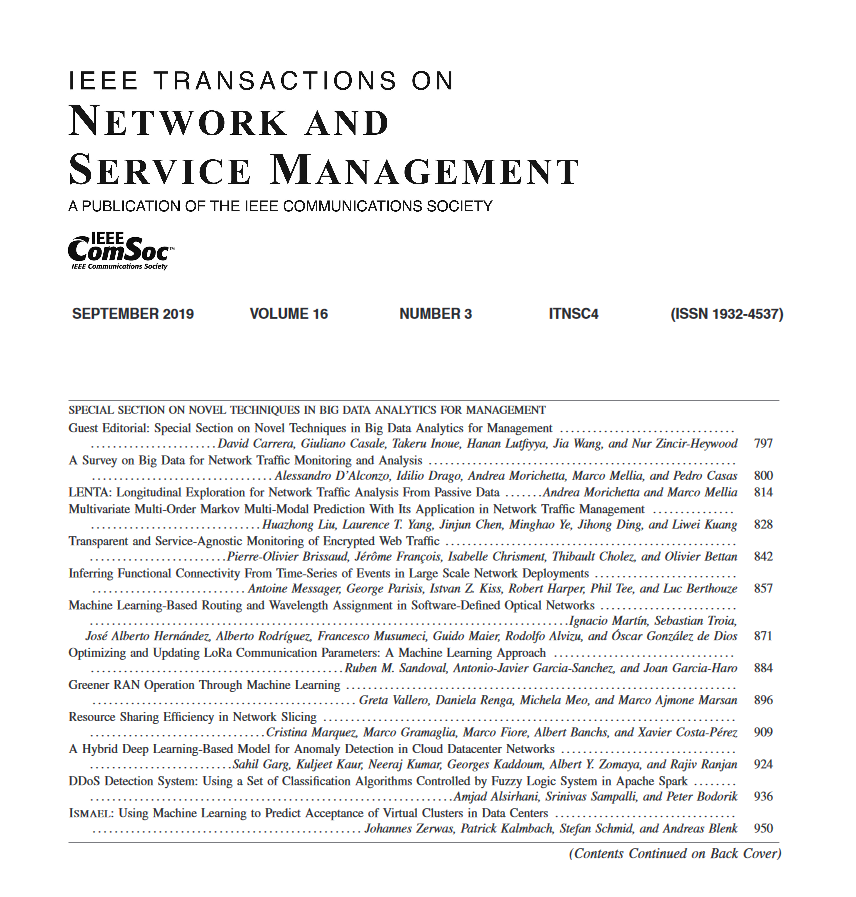Deterministic and Dynamic Joint Placement and Scheduling of VNF-FGs for Remote Robotic Surgery
IF 5.4
2区 计算机科学
Q1 COMPUTER SCIENCE, INFORMATION SYSTEMS
IEEE Transactions on Network and Service Management
Pub Date : 2025-02-20
DOI:10.1109/TNSM.2025.3539183
引用次数: 0
Abstract
During a Remote Robotic Surgery (RRS) session, multimodal data traffic with different requirements is initiated. In order to achieve a cost-effective deployment of such a system, it is crucial to tailor resource allocation policies based on the different quality of service (QoS) requirements of each data traffic. In this paper, we focus on resource allocation in a 5G-enabled tactile Internet RRS system using network function virtualization (NFV). In particular, we investigate the joint placement and scheduling of Virtualized Network Functions (VNFs) in a RRS system under both deterministic and dynamic settings. An integer linear program (ILP) is used to formulate the problem. Due to its high computational complexity, we first propose an efficient greedy algorithm to solve the ILP under deterministic settings. Simulation results show that our proposed algorithm achieves near-optimal performance and outperforms the benchmark solutions in terms of cost and admission rate. It can reduce cost by up to 37% and improve admission rate by up to 34% while satisfying both latency and reliability constraints. Furthermore, our results show that modeling the multimodal data traffic by multiple VNF Forwarding Graphs (VNF-FGs) with different QoS requirements achieves a significant gain in terms of cost and acceptance rate compared to modeling it by a single VNF-FG with the most stringent requirements. We then considered a dynamic environment where latency variations and traffic arrivals may occur over time. Using the principles of optimal stopping theory, we propose an adaptive dynamic scheduler that is capable of triggering recalculations of the existing optimal solution based on the observed cumulative number of traffic arrivals and latency violations without the need for predictions. Our proposed optimal scheduler minimizes the migration cost compared to other schedulers.远程机器人手术中vnf - fg的确定性和动态关节放置与调度
在远程机器人手术(RRS)会话期间,启动了具有不同需求的多模式数据流量。为了实现这种系统的经济高效部署,根据每个数据流量的不同服务质量(QoS)需求定制资源分配策略至关重要。本文重点研究了基于网络功能虚拟化(NFV)的5g触觉互联网RRS系统的资源分配。特别地,我们研究了在确定性和动态设置下RRS系统中虚拟网络功能(VNFs)的联合放置和调度。用整数线性规划(ILP)来表述该问题。由于其计算复杂度高,我们首先提出了一种求解确定性设置下ILP的高效贪心算法。仿真结果表明,我们提出的算法达到了接近最优的性能,并且在成本和准入率方面优于基准解决方案。在满足延迟和可靠性约束的同时,它可以降低高达37%的成本,提高高达34%的准入率。此外,我们的研究结果表明,通过具有不同QoS要求的多个VNF转发图(VNF- fg)建模多模态数据流量,与使用最严格要求的单个VNF- fg建模相比,在成本和接受率方面获得了显著的收益。然后我们考虑了一个动态环境,其中延迟变化和流量到达可能随着时间的推移而发生。利用最优停车理论的原理,我们提出了一种自适应动态调度程序,它能够在不需要预测的情况下,根据观察到的累积交通到达数量和延迟违规触发对现有最优解的重新计算。与其他调度器相比,我们提出的最优调度器可将迁移成本降至最低。
本文章由计算机程序翻译,如有差异,请以英文原文为准。
求助全文
约1分钟内获得全文
求助全文
来源期刊

IEEE Transactions on Network and Service Management
Computer Science-Computer Networks and Communications
CiteScore
9.30
自引率
15.10%
发文量
325
期刊介绍:
IEEE Transactions on Network and Service Management will publish (online only) peerreviewed archival quality papers that advance the state-of-the-art and practical applications of network and service management. Theoretical research contributions (presenting new concepts and techniques) and applied contributions (reporting on experiences and experiments with actual systems) will be encouraged. These transactions will focus on the key technical issues related to: Management Models, Architectures and Frameworks; Service Provisioning, Reliability and Quality Assurance; Management Functions; Enabling Technologies; Information and Communication Models; Policies; Applications and Case Studies; Emerging Technologies and Standards.
 求助内容:
求助内容: 应助结果提醒方式:
应助结果提醒方式:


